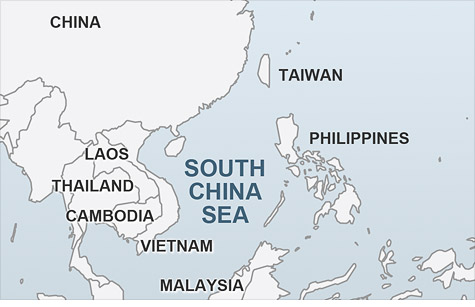Search News

China has harassed ships and told oil firms to stop drilling in the South China Sea. But the region could see an energy bonanza, if everyone could get along.
NEW YORK (CNNMoney) -- Tensions between China and other nations bordering the South China Sea are escalating, with the oil and gas resources that lie beneath those waters playing a central role.
Conservative projections estimate that the South China Sea contains 4.8 billion barrels of oil and 64 trillion cubic feet of natural gas, according to the United States Geological Survey. That's equivalent to Alaska's discovered oil reserves, and more than the discovered gas reserves in the Gulf of Mexico.
China, Vietnam, the Philippines and Malaysia have long been in a dispute over who controls the region's vast resources. At issue is not just oil and gas, but also fishing and mineral rights.
China says that it has rights to just about all of the sea's resources, and its neighbors allege that it's been acting in a hostile manner as a result.
"China has amassed considerable economic power over the last few years," said Ernest Bower, director of the Southeast Asia Program at the Center for Strategic and International Studies. "It believes it has the leverage now, and it's testing it."
Bower says there have been 23 incidents of confrontation in the region over the last three years. The most recent was earlier this month, when the Philippines' largest naval vessel became locked in a standoff with two Chinese maritime surveillance ships after the Philippines confronted Chinese fishing vessels in contested waters.
Last spring a British ship conducting survey work off the Philippine coast for Forum Energy was chased off by Chinese gunboats. Shortly thereafter, the Vietnamese government said a Chinese patrol boat cut a submerged cable belonging to a ship operated by the Vietnamese state oil company.
Also last year, analysts say Exxon Mobil (XOM, Fortune 500) was told by the Chinese government that if it didn't stop searching for oil off the coast of Vietnam, it would be banned from Chinese markets.
An Exxon spokesman wouldn't comment on any discussions with the Chinese, but did say the company plans to continue drilling off Vietnam.
But BP has stopped exploring for oil off Vietnam. A BP (BP) spokesman said the company sold those assets to help pay for the Gulf of Mexico spill, but analysts say that move was at least partly due to threats from the Chinese government.
Most of the big international oil firms are operating in the region. In addition to Shell, Chevron (CVX, Fortune 500) is working nearby in the Gulf of Thailand, while U.S.-based Murphy (MUR, Fortune 500) and Exxon both have operations in Malaysia.
The tensions in the area are part of the reason why the United States is embarking on what Secretary of State Hilary Clinton has called a "pivot" toward Asia.
That strategy aims to give the United States a greater presence in the region, and to help counter any threats from China. The United States' primary interest in the region is to guarantee freedom of passage for ships -- one third of the world's global trade passes through the South China Sea.
The U.S. presence was increased noticeably earlier this month with the deployment of 2,500 U.S. Marines to northern Australia.
The risk of an outright military conflict is growing, said Michal Meidan, an Asia analyst at the Eurasia Group, a political risk consultancy. While up until now the sparring parties have pulled back just before a major conflict, "no one wants to appear weak," she said.
Still, the situation isn't entirely grim.
Bower, from the Southeast Asia Program at the Center for Strategic and International Studies, said it's still possible -- even likely, in his view -- that the nations will come together and develop the sea's rich resources for everyone's benefit.
"Everyone loses in a conflict scenario, but the upside to this is fantastic," he said. ![]()
| Overnight Avg Rate | Latest | Change | Last Week |
|---|---|---|---|
| 30 yr fixed | 3.80% | 3.88% | |
| 15 yr fixed | 3.20% | 3.23% | |
| 5/1 ARM | 3.84% | 3.88% | |
| 30 yr refi | 3.82% | 3.93% | |
| 15 yr refi | 3.20% | 3.23% |
Today's featured rates:
| Latest Report | Next Update |
|---|---|
| Home prices | Aug 28 |
| Consumer confidence | Aug 28 |
| GDP | Aug 29 |
| Manufacturing (ISM) | Sept 4 |
| Jobs | Sept 7 |
| Inflation (CPI) | Sept 14 |
| Retail sales | Sept 14 |